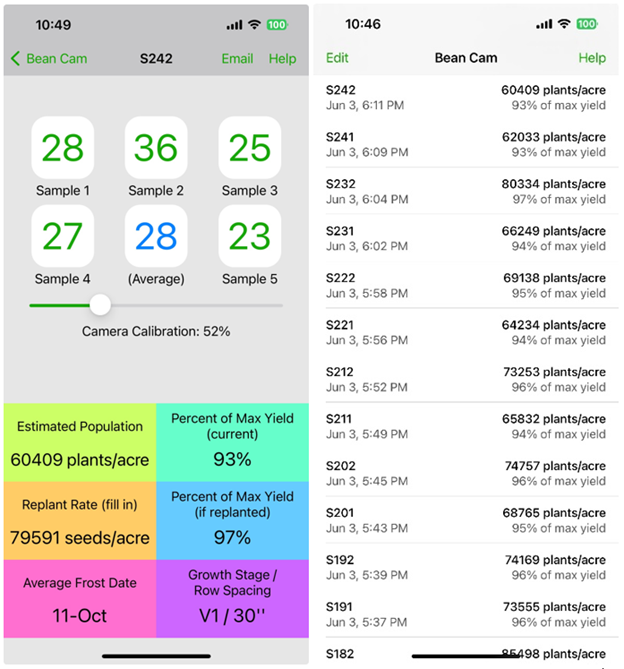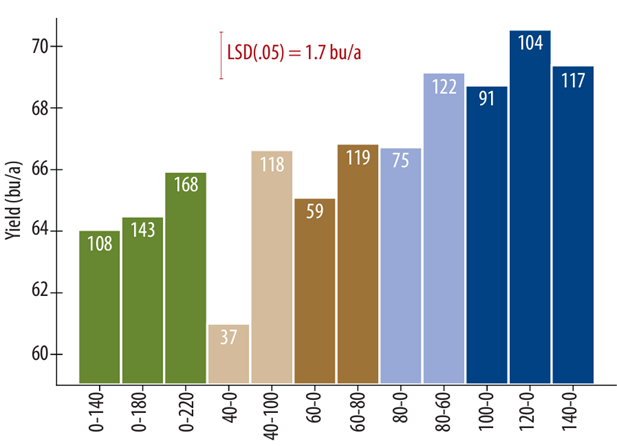Assessing soybean stands
Being able to compare seeding rate against emerged plant populations helps with a number of management decisions including whether a replant is necessary.

Every farmer knows that the number of seeds dropped per acre is never the number of plants that will survive and contribute to yield. As the adage goes, “Yield potential is highest when the seed is still in the bag.” Numerous biological and environmental challenges can prevent a seed from germinating, emerging and growing to maturity, including diseases, insect damage, high-salt fertilizer injury, soil crusting, too little or too much soil moisture, frost damage, wildlife feeding and many others. If these factors impact stand shortly after planting, farmers should assess the stand count and decide whether replanting is economically beneficial.
Soybeans require approximately 130 cumulative growing degree units (GDUs base 50 degrees Fahrenheit) to emerge. To calculate GDUs, also known as growing degree-days (GDDs), take the daily average soil temperatures [(max + min) ÷ 2] and subtract 50. For temperatures less than 50 F, use 50 and if greater than 86 F, use 86. When soils are around 50 F, emergence could take two to three weeks or longer, but with soil temperatures of 70-90 F, it can occur in less than a week.
University of Wisconsin-Madison’s Shawn Conley and John Gaska found that 50% soybean emergence occurred at 130 GDUs and 90% emergence occurred at 155 GDUs with several varieties tested (“Predicting When Soybeans Will Emerge”). However, Shaun Casteel of Purdue University showed that 141 GDUs were required to achieve 50% emergence and 200 GDUs were required for 90% emergence (“Soybean Stands: Emergence? Replant?”). Growers should assess stands within one to two weeks of expected emergence to determine whether sufficient plant density exists to achieve maximum yields.
There are several methods for assessing stands—below are four, from old school to high tech. For all of these, be sure to count plants that you believe will survive—avoid those that are missing both cotyledons, bruised/rotted below the cotyledons, etc. Sample from areas that represent the majority of the field—don’t pick areas that look really thin or really dense. Remember, as with any sampling (e.g., soil fertility, soybean cyst nematode counts, tissue nutrient concentration), you are trying to estimate the entire field based on a very small sample size, so the greater the area and number of samples used, the more accurate your estimate will be.
Four methods for assessing stands:
- Plants per linear feet of row. Measure some distance of row length and count the number of soybean plants in that distance. Refer to Table 1 to determine the stand count per acre for your row spacing.
- Hula hoop. This is similar to method #1 but using the area within a hula hoop rather than linear feet of row. Refer to Table 2 for stand count estimates with this method.
- BeanCam. The Wisconsin Soybean Replant Calculator, also known as BeanCam, a smart phone app developed by the University of Wisconsin, is available for both iPhone and Android platforms. Select the growth stage (VC, V1 or V2) and row spacing (7.5, 15 or 30 inches) to begin. Then, hold your phone over the field, take a picture, take an actual count of plants in that area and enter that number to calibrate the app. Once the calibration is complete, take four more pictures—the app will calculate the average stand count for the field (Figure 1).
- Drone imagery. Several companies have developed algorithms to conduct stand counts using aerial imagery on crops including soybean. Most require a subscription (if you have your own drone and want to fly the field yourself and upload images), but you can also hire local companies to do everything. Weeds may confound these counts, and when soybeans grow to where neighboring plants are touching, the algorithms have a hard time detecting differences between plants. Similar to BeanCam, use this method between VC and V2.
|
Table 1. Plant density for common row widths based on the average number of plants/foot of row. Adapted from “Soybean Replant Decisions: PM 1851,” Iowa State University Extension. |
|||||
|
|
Plants per acre |
||||
|---|---|---|---|---|---|
|
|
Row width (inches) |
||||
|
Plants/foot |
30 |
20 |
15 |
10 |
7 |
|
1 |
17,400 |
26,100 |
34,800 |
52,300 |
74,700 |
|
2 |
34,800 |
52,300 |
69,700 |
104,500 |
149,300 |
|
3 |
52,300 |
78,400 |
104,500 |
156,800 |
224,000 |
|
4 |
69,700 |
104,500 |
139,400 |
209,100 |
298,700 |
|
5 |
87,100 |
130,700 |
174,200 |
261,400 |
373,400 |
|
6 |
104,500 |
156,800 |
209,100 |
313,600 |
|
|
7 |
122,000 |
183,000 |
243,900 |
|
|
|
8 |
139,400 |
209,100 |
278,800 |
|
|
|
9 |
156,800 |
235,200 |
313,600 |
|
|
|
10 |
174,200 |
261,400 |
|
|
|
|
11 |
191,700 |
287,500 |
|
|
|
|
12 |
209,100 |
313,600 |
|
|
|
|
13 |
226,500 |
|
|
|
|
|
14 |
243,900 |
|
|
|
|
|
15 |
261,400 |
|
|
|
|
|
Table 2. Factors for various hoop diameters for calculating the number of plants per acre using the hula hoop method. For example, if a hoop has a diameter of 30 inches, multiply the number of plants inside the hoop by 8,878 to determine the number of plants per acre. Adapted from “Thin Soybean Stands: Should I Replant, Fill In, or Leave Them Alone?,” Purdue University Extension. |
|
|
Diameter of hoop (inches) |
Factor* |
|---|---|
|
24 |
13,873 |
|
26 |
11,820 |
|
28 |
10,192 |
|
30 |
8,878 |
|
32 |
7,803 |
|
34 |
6,912 |
|
36 |
6,166 |
|
* Multiplier = 43,560 ÷ [(hoop radius^2 x 3.14) ÷ 144] |
|

Once you have a reasonably accurate stand estimate, decide whether a replant is necessary. Most researchers state that a stand of 100,000 to 120,000 plants per acre will achieve maximum yields. But what about thinner stands? In a seven-year on-farm trial, Michigan State University Extension senior soybean educator Mike Staton showed that high yields can be produced from stands as low as 60,000 to 70,000 plants per acre (“Thin soybean stands can produce surprisingly high yields”).
Though there is not perfect consensus about the minimum stand below which replant should be considered, here are several estimates from across the Midwest:
- 70,000 to 75,000 plants per acre that are healthy and uniformly distributed are required to produce yields 95% of maximum (“Soybean Plant Stands: Is Replanting Necessary?”, Science for Success collaboration)
- Replant if less than 75,000 plants per acre when planted prior to mid-May or less than 50,000 – 60,000 plants per acre when planted late May into June (“Stand Assessments – Soybean”, Iowa State University Extension)
- Replant if less than 70,000 plants per acre (“Soybean Stands: Emergence? Replant?”, Casteel, Purdue University)
- Replant if less than 55,000 plants per acre (“Soybean Replant Decisions: Just the Facts Jack!”, Conley, University of Wisconsin-Madison)
- Replant if less than 50,000 plants per acre at VC (“Replanting Decisions in Corn and Soybeans… What to Consider”, Ortez, Lindsey and Lindsey, The Ohio State University Extension)
High-yielding areas of the field will be less impacted by low plant populations than low-yielding areas, and since soybeans are “plastic” and will branch out and compensate for lower densities, keeping a thin stand may be the most economically beneficial option. See Figure 2 for a summary of research conducted at University of Wisconsin-Madison with various replant scenarios.

The number printed at the tops of the bars represent the final plant stand (1000 plants per acre) after replanting. Numbers below the bars represent the initial seeding rate followed by the replant rate (1,000 seeds per ac). Excerpted from “Think Twice Before Replanting Soybeans,” Gaspar A., Conley S. and Gaska J., University of Wisconsin-Madison.
If it is decided to replant, plan to do so without destroying the initial planting, which would essentially reset the clock and result in a late planting with lost yield potential. Offset the planter from the existing rows or plant at a slight angle or perpendicular to the existing rows. You will need to take into account expected losses due to running down beans in the replant operation. Keep in mind that final plant date for soybeans in Michigan is June 15 for federal crop insurance, which may also restrict some growers.
This article was originally published in the Michigan Soybean Committee Magazine summer edition.



 Print
Print Email
Email